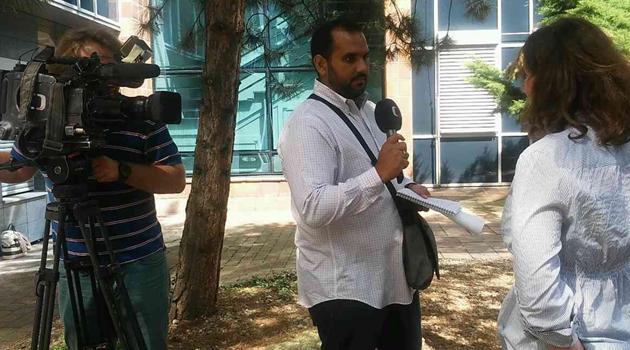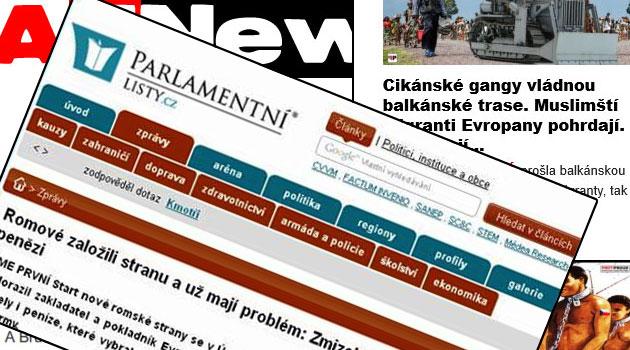Roma in the Czech news - from the perspective of a Romani media trainee

During the summer those attending the Media Training run by the ROMEA organization had the opportunity to visit the places where news and reporting are created in the Czech Republic. Under the direction of Romani journalists Richard Samko (Czech Television), Patrik Banga (iDNES.cz) and Tomáš Bystrý (Czech Radio), they got to test in practice with it means to be a journalist.
Participant Lukáš Džurban got to visit the newsroom of the online news server iDNES.cz. The following is his report on what he took away from the Media Training.
Lukáš Džurban: Roma in the news
Picture a Romani man who is in the news – on television or in the print media. This time, though, he’s not there as a negative figure like a murderer, thief, or other subversive element.
This time, he’s the one delivering the interesting information. That is one possible outcome of the Media Course the ROMEA organization has been running since May.
What does the work of an editor or journalist entail? What actually happens behind the scenes of the television news, or the reports we read when we surf the net?
Is it even possible to get into the media field as a practitioner? Will I find my future profession in such work?
Those are the questions that interested me and my colleagues in the course. Each of us was attending for a different reason, but what we had in common was that we knew very little about journalism and basically did not know what to expect.
I found out about the course through Facebook because I follow the ROMEA organization’s profile there. The article referred to news server Romea.cz, where the course was described.
The course was open to anybody who wanted to attempt a change of profession and was interested in working as a journalist. At that time I was working as a dispatcher.
I consider the work of a dispatcher to be a standard job, something common and necessary. I am paid for my work and get 14 days off per month.
Why not try something new? I decided to open a new door and see what was on the other side – that was my original impulse for responding to the offer.
On the morning of 14 May I was thinking about what to wear, and finally I chose a shirt and tie and set off for my entrance interview. Just before 11 AM I made it to the House of National Minorities in Prague, where I was welcomed by the course coordinator, Lenka Jandáková.
I met several of my future colleagues who were, like me, waiting to take several entrance tests – for example, in the Czech and Romani languages. I hadn’t written anything like that by hand since school.
During the interview we were “grilled” by a commission comprised of Romani journalists working for Czech media outlets and the former Editor-in-Chief of news server Roema.cz. They were most interested in why we had applied for the course.
Several days later I got an email letting me know I had been accepted. From my perspective the aim of the course was to open up for Romani people the option of applying themselves in the media.
I also perceived an effort to motivate those around us, to bring a bit of light into the dim – or rather, the dark – awareness about Romani people that predominates in the majority society here. We underwent several trainings with this focus.
The introductory training was with Michal Komárek, who did his best to convey to us the know-how of how to write a news report. Overall this is a common, logical matter, but it also involved some new concepts and contexts.
We already knew that a news item should be current, readable, not boring, and should answer the basic questions of Who, What, When, Where, How and Why. This course, though, led us into various other considerations, debates and disputes.
At some moments the instructor had to rein us in because we were involved in the debates with so much of our own emotions and verve. We then attempted to write news items, rewriting information from a Czech News Agency report in a readable form with a limited amount of content.
The instructor gave us immediate feedback on our creations. Unfortunately, I was unable to join my colleagues for the second training.
Under the direction of Tomáše Bystrý, my colleagues learned more important informaton about how to write a news item correctly. The third meeting was in ROMEA’s new office space.
The instructor for that segment was Patrik Banga. There we learned the difference between a news item and reportage.
He showed us several of his own pieces and taught us what a blog – the modern form of written expression – should look like. We attempted to write a reportage on our own during the training.
We received constructive, immediate feedback about our efforts. Then we went on our first field trip of the summer, to the Czech Television building, where we were invited by Richard Samko.
We arrived there the day after a disruptive night in Turkey. The news was full of information about an attempt to depose the current government there.
We were able to experience for ourselves the atmosphere of the very place where the news reports that we had turned on in the morning over our coffee had been created. During the day we had the opportunity to peer behind the scenes of the Czech Television reporters’ work.
We were given microphones to carry, stood before the camera, and attempted to say a few sentences. Well, nobody got famous – it’s better never to see yourself on camera that way.
We then edited the videos we filmed, added the recorded sound to the selected images, and with the aid of a skilled young woman in the editing booth, we turned the entire thing into a reportage. It was an interesting day, interesting work – and we learned that there are many people in the background of a news item that can take, in the best-case scenario, just a couple of minutes to watch.
The other actual media environment we had the opportunity to get to know was the editorial offices of iDNES.cz. We arrived there on a day when the world woke up more or less calmly.
There were no military putsches or terrorist attacks to report on. Patrik Banga, who runs the blog section of iDNES.cz, showed us his own workplace and the entire editorial offices.
The day was about how the electronic (online) media work. How blogs are produced, how headlines are chosen, etc.
We attempted to write our first blog on the topic of the media training course up to that point. We also filmed some footage for the ever more popular blog form called video blogging, and I was curious to see what kind of face I had managed to pull for the camera.
So, are those of us who attended the course able to function independently now? Can we write news items or reportages?
For now I’d say my own output doesn’t yet have the correct education behind it needed for me to compete in the marketplace. However, I am glad that these doors opened for me.
Where I will ultimately end up is a question to which I don’t know the answer. For now.
ROMEA’s Media Training for Romani people interested in journalistic work was implemented thanks to support from Bader Philanthropies.
